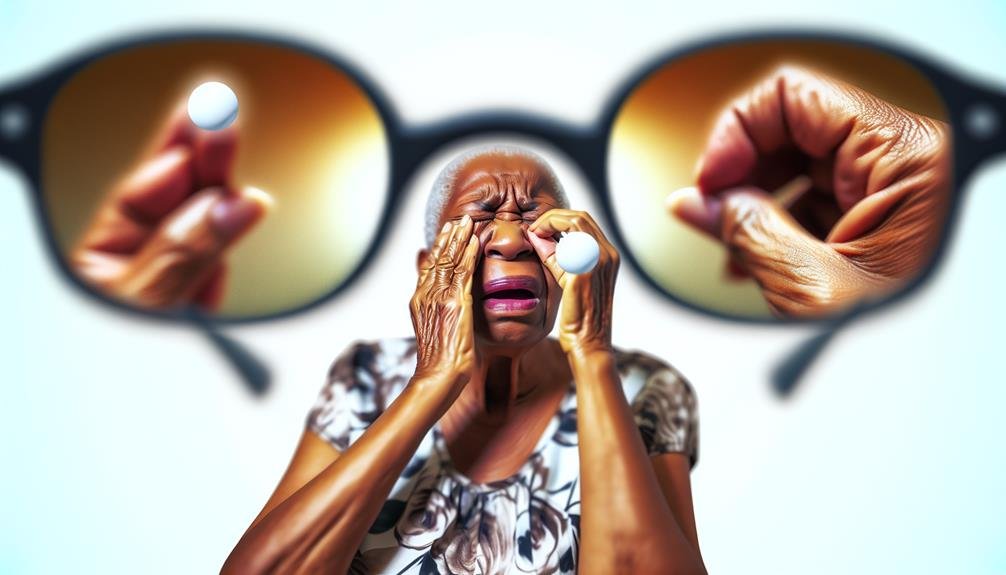
As you age, your eyes undergo changes that can lead to various vision problems. From the cloudiness of cataracts to the optic nerve damage of glaucoma, each issue presents unique challenges to your eyesight. These conditions can impact your daily life and independence, making it crucial to stay informed about the signs and symptoms. By understanding these common vision problems in the elderly, you can take proactive steps to safeguard your eye health and ensure a clearer future ahead.
Key Takeaways
- Cataracts cause cloudy vision and sensitivity to glare.
- Glaucoma damages the optic nerve, leading to vision loss.
- Macular degeneration affects central vision and requires early detection.
- Diabetic retinopathy damages retinal blood vessels, causing blurred vision.
- Presbyopia affects close vision and may require reading glasses.
Cataracts
Cataracts develop when the natural lens of the eye becomes cloudy, leading to blurred vision and difficulty seeing clearly. This cloudiness occurs due to the clumping of proteins in the lens, which interferes with the passage of light into the eye. As a result, your vision may appear fuzzy or as if you’re looking through a foggy window. Cataracts are commonly associated with aging but can also be caused by factors such as smoking, diabetes, and prolonged exposure to sunlight.
If you have cataracts, you may notice that colors appear duller, and you may experience increased sensitivity to glare, particularly when driving at night. As the cataract progresses, everyday tasks like reading or recognizing faces may become more challenging. Fortunately, cataracts can be surgically removed, with the cloudy lens being replaced by an artificial one to restore clear vision. It’s essential to consult an eye care professional if you suspect you have cataracts to determine the best course of action for your specific situation.
Glaucoma
Glaucoma is a group of eye conditions that can damage the optic nerve, leading to vision loss if left untreated. The main cause of glaucoma is usually an increase in intraocular pressure, which can occur when the fluid in the eye doesn’t drain properly. This pressure can gradually damage the optic nerve fibers, resulting in peripheral vision loss that can progress to central vision if not managed effectively.
There are several types of glaucoma, with primary open-angle glaucoma being the most common. This type often develops slowly and may not have noticeable symptoms until significant vision loss has occurred. Acute angle-closure glaucoma, on the other hand, can cause sudden symptoms like severe eye pain, headache, blurred vision, and nausea, requiring immediate medical attention to prevent permanent vision damage.
Regular eye exams are crucial for early detection of glaucoma since treatment can help slow or prevent further vision loss. Treatment options include eye drops, oral medications, laser therapy, or surgery, depending on the type and severity of the condition. It’s important to follow your eye doctor’s recommendations to preserve your vision and overall eye health.

Macular Degeneration
Macular degeneration, also known as age-related macular degeneration (AMD), is a common eye condition that affects the central part of the retina, called the macula. This condition can lead to a loss of central vision, making it difficult to perform tasks like reading or recognizing faces. There are two main types of macular degeneration: dry AMD, which progresses slowly, and wet AMD, which can lead to rapid vision loss.
To better understand the differences between dry and wet AMD, let’s look at this table:
| Feature | Dry AMD | Wet AMD |
|---|---|---|
| Progression | Slow | Rapid |
| Abnormal Blood Vessels | Absent | Present |
Early detection and treatment are crucial in managing macular degeneration, especially in the wet form where abnormal blood vessel growth can cause severe vision loss. Regular eye exams are essential for monitoring any changes in your vision and receiving timely interventions to preserve your sight.
Diabetic Retinopathy
When you have diabetic retinopathy, it means that the blood vessels in your retina are damaged due to diabetes. This condition can lead to vision loss if left untreated.
Monitoring your blood sugar levels, controlling blood pressure, and regular eye exams are crucial in managing diabetic retinopathy.
Causes of Diabetic Retinopathy
Diabetic retinopathy develops when high levels of blood sugar damage the blood vessels in the retina, leading to vision problems in the elderly. The primary cause of this condition is prolonged exposure to high blood sugar levels, which weakens and damages the tiny blood vessels that nourish the retina.

As a result, these blood vessels may swell, leak fluid, or close off, disrupting the normal blood flow to the eye. Additionally, the body may respond by growing new but weak blood vessels on the surface of the retina, which can easily break and bleed.
Over time, these changes can lead to vision loss and other complications if left untreated. Managing blood sugar levels effectively is crucial in preventing diabetic retinopathy.
Symptoms to Watch for
Damage to the blood vessels in the retina due to prolonged exposure to high blood sugar levels can result in various symptoms that individuals should watch for in diabetic retinopathy. These symptoms may include:
- Blurred or distorted vision
- Floaters or dark spots in the vision
- Sudden loss of vision
It’s crucial to monitor your vision regularly if you have diabetes, as early detection of these symptoms can lead to timely intervention and better management of diabetic retinopathy. If you experience any of these signs, consult an eye care professional promptly for further evaluation and appropriate treatment.
Regular eye exams are essential in detecting diabetic retinopathy in its early stages.
Treatment Options Available
Early detection and prompt treatment of diabetic retinopathy are crucial in preserving vision and preventing further damage to the eyes. Treatment options for diabetic retinopathy include laser surgery, injections of anti-VEGF medications, and corticosteroids.

Laser surgery helps to seal leaking blood vessels and prevent new abnormal vessel growth. Anti-VEGF medications are injected into the eye to reduce swelling and leakage from the abnormal blood vessels. Corticosteroids can also be used to reduce inflammation in the eye.
In more severe cases, vitrectomy surgery may be necessary to remove blood and scar tissue from the eye’s vitreous gel. It’s essential to consult with an ophthalmologist to determine the most suitable treatment option based on individual circumstances.
Presbyopia
Presbyopia is a common age-related condition that affects the eye’s ability to focus on close objects. As you age, the lens of your eye becomes less flexible, making it harder to see things up close.
Here are some key points about presbyopia:
- Gradual Onset: Presbyopia usually develops slowly over time, starting around the age of 40 and progressing until around age 65 when it stabilizes.
- Symptoms: You may notice difficulty reading small print, eye strain when working on close tasks, or the need to hold reading material at arm’s length.
- Treatment: Options for managing presbyopia include wearing reading glasses, bifocals, progressive lenses, or undergoing refractive surgery like monovision LASIK to improve near vision.
If you’re experiencing changes in your near vision, it’s essential to have regular eye exams to monitor and address any vision issues that may arise due to presbyopia.
Dry Eyes
If you’re experiencing discomfort, burning, or blurred vision, you might be dealing with dry eyes. Causes can range from aging, medication side effects, to environmental factors like dry air or screen time.

Treatments may include artificial tears, prescription eye drops, or lifestyle adjustments to alleviate symptoms and improve eye health.
Causes of Dry Eyes
Dry eyes can be caused by a variety of factors, ranging from environmental conditions to certain medications. Some common causes include:
- Aging: As you get older, your eyes may produce fewer tears, leading to dryness.
- Environmental Factors: Factors like windy, smoky, or dry climates can increase evaporation of tears.
- Medications: Certain medications such as antihistamines, decongestants, and antidepressants can reduce tear production.
These factors can disrupt the delicate balance of tear production and evaporation, resulting in dry eyes. Understanding the underlying causes can help in managing and treating this uncomfortable condition.
Treatment Options for Dry Eyes
A key aspect in managing dry eyes is exploring various treatment options tailored to address the specific underlying causes of the condition.
Artificial tears are a common first-line treatment, providing lubrication and moisture to the eyes. For individuals with meibomian gland dysfunction, warm compresses and eyelid massages can help improve oil gland function.
Prescription eye drops, such as cyclosporine or lifitegrast, may be recommended to reduce inflammation and increase tear production. In more severe cases, punctal plugs can be inserted to block the tear ducts and conserve natural tears.

Lifestyle modifications like using a humidifier, wearing wraparound glasses outdoors, and taking omega-3 supplements can also alleviate dry eye symptoms. Consulting an eye care professional is crucial to determine the most suitable treatment plan for your specific condition.
Floaters and Flashes
Experiencing sudden onset floaters and flashes in your vision can be a concerning symptom that warrants prompt evaluation by an eye care professional. Floaters are often described as dark spots, lines, or cobweb-like shapes that seem to drift in your field of vision, while flashes can appear as flickers of light. Here’s what you need to know about floaters and flashes:
- Floaters: Small pieces of debris in the vitreous gel inside the eye can cast shadows on the retina, leading to the perception of floaters.
- Flashes: Flashes of light can be caused by the vitreous gel pulling on the retina, which may indicate a risk of retinal detachment.
- Risk Factors: Age-related changes in the vitreous, eye injuries, and certain medical conditions like diabetes can increase the likelihood of experiencing floaters and flashes.
If you notice a sudden increase in floaters and flashes, especially accompanied by vision loss or a curtain-like shadow over your visual field, seek immediate medical attention to rule out any serious underlying conditions.
Conclusion
Now that you’re aware of the common vision problems in the elderly, remember that your eyes are like windows to the world. Take care of them like precious gems, seeking regular check-ups and prompt treatment when needed.
Just as a skilled artist carefully tends to their masterpiece, nurture your eyes with attention and care. Embrace the beauty of clear vision and vibrant colors, for your eyes are truly priceless treasures.




